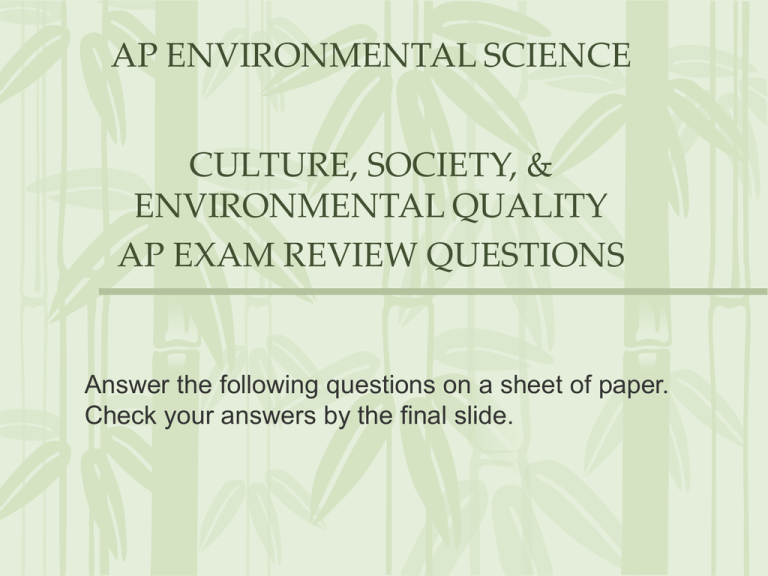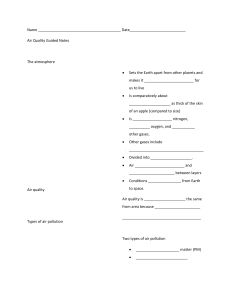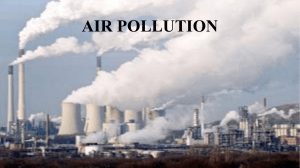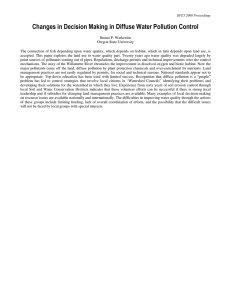AP ENVIRONMENTAL SCIENCE
advertisement

AP ENVIRONMENTAL SCIENCE CULTURE, SOCIETY, & ENVIRONMENTAL QUALITY AP EXAM REVIEW QUESTIONS Answer the following questions on a sheet of paper. Check your answers by the final slide. 1. The release of CFCs was banned under an international treaty written in which of the following cities? a. Montreal b. New York c. New Delhi d. Kyoto e. Washington 2. Which of the following is a function of the Hazardous Materials Transportation Act? a. dictates how sanitary landfills are to be built b. defines which materials are labeled “Hazmat” c. limits point source water pollution d. defines the maximum amounts of six different air pollutants e. states how mines must be reclaimed 3. Which of the following policies prevents the harassment, capture, injury, or killing of all species of whales, dolphins, seals, and sea lions, as well as walruses, manatees, dugongs, sea otters, and polar bears? a. National Fisheries Act b. CITIES c. Clean Water Act d. The Marine Mammal Protection Act e. Maritime Safety Act 4. When a large federal project might have a significant impact on the environment, which of the following must be drafted? a. a cost-benefit analysis b. a interagency review c. a report from the geographical information system d. an environmental impact statement e. a needs statement 5. Rachel Carson described which of the following problems to Americans? a. pesticide bioaccumulation and processing b. the beauty of nature c. loss of sustainable forest practices d. the problem of the Tragedy of the Commons e. America’s diminishing oil reserves 6. Which of the following established the “emissions trading policy”? a. Clean Water Act b. Resource Conservation and Recovery Act c. Asbestos Hazard Emergency Response Act d. The Kyoto Protocol e. Clean Air Act 7. All of the following deal with the study of environmental economics EXCEPT a. the study of the impact of goods on the ecosystem. b. understanding the economic cost of pollution. c. developing policy alternatives to pollutionbased industry. d. the relative environmental costs and benefits of proposed policies. e. the location of new mineral resources. 8. The listing of threatened species and the purchase of land to protect their habitats is legislated in which of the following? a. Federal Noxious Weed Act b. Endangered Species Act c. Convention on Biological Diversity d. Fish and Wildlife Conservation Act e. Migratory Bird Conservation Act 9. Which of the following philosophies would be held by someone with a holistic veiwpoint on the management of the earth’s resources? a. There are no problems; let’s do whatever we want. b. The free market works best, ad the government should not interfere. c. We can manage most problems with technology. d. The biodiversity of the earth is the most important issue and we need it to sustain us. e. Humans are the most dominant species on the planet, and we can solve any environmental problems. 10. Which of the following best describes the goal of environmentally sustainable economic growth? a. allowing rapid population growth so there will be more workers b. exploration to find more natural resources c. increasing the quality of good without depleting the natural resources needed to make the goods d. cutting down forests and replacing them with rangeland e. growing more crops by using larger amounts of fertilizer 11. A cap-and-trade policy might be effective in controlling which type of the following pollutants? a. thermal pollution in rivers b. organic waste pollution in oceans c. underground water pollutants d. noise pollution in a city e. carbon dioxide in the atmosphere 12. Which of the following can be classified as an NGO? a. World Wildlife Fund b. Bureau of Land Management c. Fish and Wildlife Commission d. International Trade Commission e. Department of Defense ANSWERS 1. A 2. B 3. D 4. D 5. A 6. E 7. E 8. B 9. D 10. C 11. E 12. A











